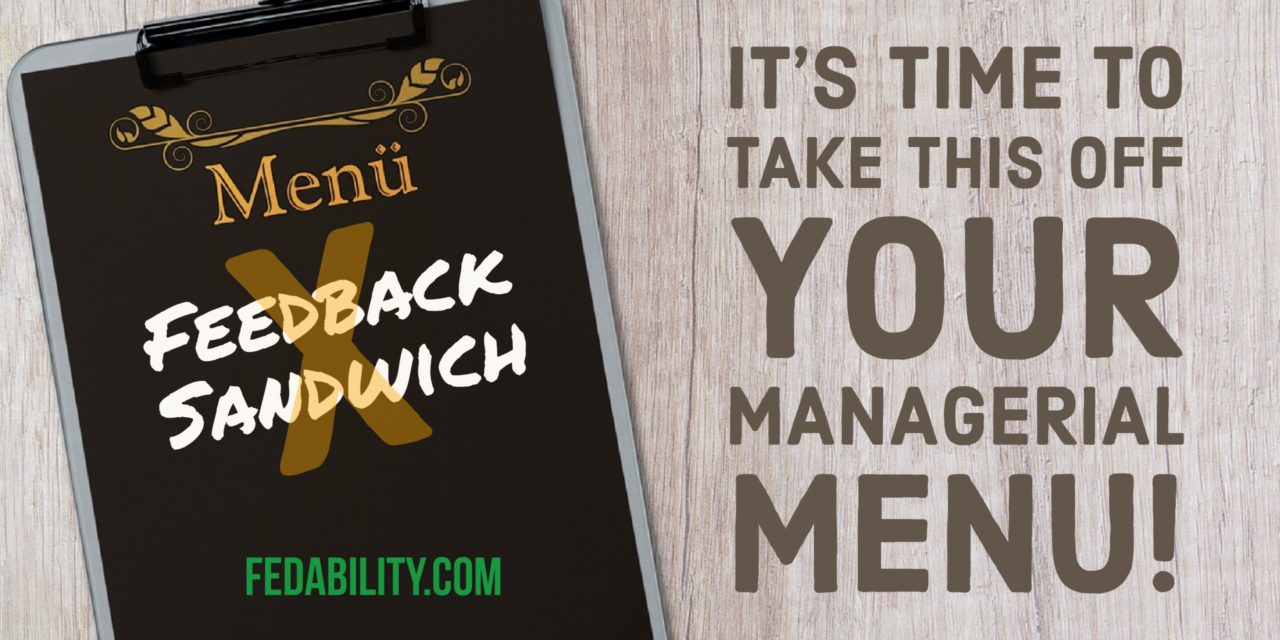There are some pieces of leadership advice that just won’t die – no matter how bad the advice. An example of this is the feedback sandwich. Not only is the feedback sandwich a contrived, formulaic approach – it’s counter productive to getting improved performance. Let’s discuss why you need to take the feedback sandwich off your managerial menu. And, what you need to be doing differently.
What is the feedback sandwich?
The feedback method encourages managers to bookend their negative or constructive criticism with positive feedback. The feedback method would sound something like this:
Positive feedback: I appreciate how you consistently meet our deadlines for submitting your reports.
Constructive feedback: After reading through the reports you submit, I find they often require more editing. As a result, we ultimately miss our deadlines. In the future, please include review time in advance of submitting your reports.
Positive feedback: Because you’re so reliable in meeting deadlines, I feel confident that you’ll be able to implement this feedback and produce even better products.
Why was the feedback sandwich created?
The feedback sandwich feedback method came about as a means for supervisors to feel more comfortable providing feedback to their employees. The concept arose to try to combat supervisors’ resistance to providing feedback to employees. It is thought that supervisors do not provide negative feedback because of the potential negative impact on the relationship with the other person. Thus, by putting something positive on the front and end of the constructive criticism (i.e., negative) it should maintain the relationship.
In reviewing this topic, I found this advice has even been extended to parents and teachers. However, the concept appears to have taken hold due to advice given by the The One Minute Manager. The One Minute Manager isn’t a bad book, this particular piece of advice just is.
Why should the feedback sandwich be tossed?
You aren’t fooling anyone
If we were to believe that the technique took hold in 2001 when the The One Minute Manager was published, that means it’s been being used for at least 17 years now (at the time of this writing). And, now it’s commonly taught in (outdated) leadership classes. So, it’s not a secret. When I’ve taught classes and asked what managers think is the best way to provide feedback – they inevitably mention the feedback sandwich.
As a result, when a manager actually goes back to their offices and starts using this ‘new feedback technique’ most people know what’s coming. That negative feedback squeezed between two contrived pieces of positive feedback.
People aren’t hearing the good anyway
In a study published in 2001, Baumeister et al summarized and extended the research on the impact of positive versus negative phenomena. Their paper is called, The bad is stronger than good. They state: “Bad emotions, bad parents, and bad feedback have more impact than good ones, and bad information is processed more thoroughly than good”.
It’s just crappy advice
My favorite reference to this feedback approach is calling it the sh*t sandwich. At it’s core, the feedback sandwich is for the manager. Not the employee. It’s selfishly designed not for the receiver but for the giver. At the end of the day, the supervisor can pat him/herself on the back for squeaking out some negative feedback. But, the employee will focus only on the negative. And, thinking the manager is just making up positive things to say. Or, said differently the employee is likely thinking the manager is trying to manipulate them. So, you see, it’s not really giving the employee a ‘spoonful of sugar’ to make the ‘medicine’ go down.
What’s the alternative to the feedback sandwich?
Start with the positive
I hear you saying: “Wait! That’s how the feedback sandwich starts too!”. True. But, I’m saying just stick with the positive. For now.
The advice varies, but the common theme in modern feedback theory is that the amount of positive feedback must outweigh the negative. As we already know from the above discussion, negative feedback has a greater weight in our minds. Some recommend at least 3 positive pieces of feedback. I am a bit more conservative. So I recommend at least 7 pieces of positive feedback before giving an employee constructive criticism.
Does this mean you need to walk into a feedback session with a list of 7 good things to say – and conclude with something negative?
No, that sounds like a feedback hoagie, which may be worse than a feedback sandwich.
What I mean is this.
Start today. Find something good the employee has done. Provide them positive feedback. Tomorrow, repeat. Find something good to give them positive feedback about. Repeat. Repeat.
The employee becomes used to receiving positive feedback. They learn that you pay attention to them. They learn that you care about them and see the good in what they do. You build a strong and trusting relationship.
Use a different formula
Now, you have built a strong, trusting relationship over the last few weeks. You are ready to give some constructive criticism. Here’s how to do it:
- State what you’ve observed. After reading through the reports you submit, I find they often require more editing.
- State the impact. As a result, our final products are being submitted late.
- Ask for their perspective. What is your perspective on the quality of your reports? Is there something I should know about?
- Listen to their answer. You may learn that they did not realize that the report needed more editing. Or, you might learn that they have too much on their plate. That they don’t have time to edit reports. Or, they may tell you they didn’t know that they were to submit the final draft to you – thinking that it was only a draft.
- Address whatever the employee brought up. This may mean clarifying expectations. It may mean that they need more training. For instance, maybe they need a writing class. Or, it may mean that you need to help them prioritize their workload.
- State your expected changes in their performance. Once you attend the writing class, I will expect that the reports you submit are polished and ready to go up the chain. Or. Now that you have less on your plate, I expect that you have time to edit your reports before you submit them on time.
- Ask if there’s any additional support the need. Is there anything else that I should know about that might prevent you from meeting this expectation?
- Finish with support. I feel confident that you can do this. Please let me know if anything else comes up that might get in your way. I’m here to help you be successful.
“Wait!”, you say. “There’s nothing positive in that formula. What about telling them that you appreciate that they consistently submit their reports on time?”, you say.
You are right.
But, remember, you’ve been giving them positive feedback for weeks now. You already told them that you have noticed that they consistently submit their reports on time. Right?!?
Take the time
The The One Minute Manager proposed the feedback sandwich for the purposes of efficiency as well as personal comfort for the supervisor. The above approach is not quick. It cannot take a minute. But, when delivering constructive criticism it’s important to remember that the employee is going to take it to heart. It will hit their self-esteem. It will not feel good.
You need to take care of your employee. Do not drop a ‘criticism bomb’ on them and walk away. You must hear their perspective. Understand what is going on. Solve the problem that’s happening from their perspective.
Take action
Now, it’s time for you to take action. I challenge you to spend this week finding good things your employees have done. I challenge you to provide no negative feedback for the week. The caveat being that hopefully you aren’t doing performance reviews this week. In which case, I recommend you waiting until next week to start.
Tell us in the comments how your week of positive feedback went. Did it feel good? How did your employees respond?
Wish your supervisor gave you feedback?
You may be reading this and thinking, “I wish my supervisor gave me feedback. Any feedback. I’d even take a feedback sandwich”. Then, I recommend you taking a look at our prior post on getting the feedback you need before your performance appraisal.






